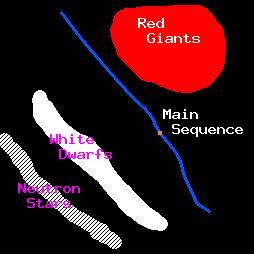Digital Demo Room
Stellar Structure and Evolution Simulator

Instructions
The simplest way to utilize this site is to view the previously made
movies on the beginner page. These movies will cover most of the
interesting general behavior in star evolution.
If you want to watch evolution of specifically massed stars, the
intermediate page should be used. Mass is by far the most important
variable in a star and changing mass or time is all you need to do to see
any kind of star.
The advanced page is used for people who want more control over the parameters.
Mass still drives the simulation, and any other variables not entered
will be set at defaults. Metalicity affects the temperature of the
star somewhat, and can be interesting.
The most useful feature of the advanced page is the random star
ability. You can specify the range you want the stars to appear in,
though a default is selected otherwise. This way, the HR diagram of a
star cluster can be shown instead of just a handful of stars.
Beginning and End time should only be changed by someone who is fairly
familiar with the times involved for the stars being evolved. The
point of changing times is to center the movie on a specific phase of
the star, but you have to know what times that phase occurs at in the
first place.
Frames affect the size and time of the movie. Both the time it takes
to make the movie and filesize of the movie are porportional to number
of frames.
Star formation is more complicated still. Initial burst is the
default option and recommended. Star bursts divides the stars the
movie would normally create into the times given below (time zero is
always included). Continous creation creates random stars (within the
range selected under number of random stars) throughout the
simulation. This simulates most known star evolution. Decreasing
continous evolution is probably the most accurate, but there are
places where it has increased or maintained a constant rate.
If only a single star is evolved, a box on the right represents the
spin and radius of that star. The radius is logarithmic and the spin
is accurate conceptually, but not numerically.
Back to Tutorial List

